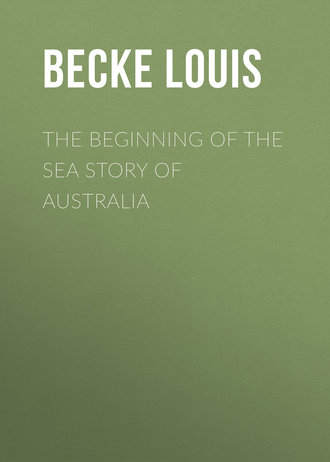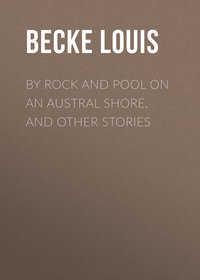 полная версия
полная версияThe Beginning Of The Sea Story Of Australia
Clarke kept a rough diary of this journey, telling of encounters with blacks, of death and madness by starvation and other privations; of how they crossed wide and shark-infested rivers by building rafts of tree branches cut down and fashioned with jack knives; of how the lives of men were purchased from the blacks by strips of clothing; and of how they counted the buttons on their ragged garments, and thus reckoned how many lives could be bought from the savages with what remained.
The terrible march lasted until the 15th of May; then three exhausted men, horrible to look upon, and the only survivors of seventeen who had, sixty days before, begun the journey, were picked up a few miles to the south of Sydney by a fishing boat.
The spot where they were seen walking along the beach was close to Port Hacking, and Clarke, three days before his rescue, had lit a fire and cooked some fish with coal he picked up. This was the first discovery of the great southern coal-fields of New South Wales.
There are other less gruesome stories than these; for example that of the Sydney whaler Policy, which, sailing under a Letter of Marque for the Moluccas, was set upon by a Dutch private ship of war—the Swift—at one time a formidable and successful French privateer. Captain Foster of the Policy, though his armament was very inferior and many of his crew were prostrated with fever, engaged the Dutchman, fought him for some hours, and brought his ship a prize into Sydney Harbour. Two Spanish vessels were captured in the same way by armed Sydney whalers; so that Australian waters have seen a little fighting.
On board the convict ships of those early days there were often mutinies, desperate and sometimes bloody, and some of these led to remarkable results. In one instance the soldiers—not the prisoners—rose upon the crew and the ship's officers, turned them adrift in an open boat, and carried off the ship. They were recaptured afterwards by a man-of-war in the Indian Ocean and brought to justice. Convict mutinies often were only suppressed after desperate hand-to-hand fighting; then a day or two later the ringleaders would be hanged from the yardarm, and a dozen or more convicts flogged at the gratings. And these things, be it remembered, were going on only an old man's lifetime ago.
New Zealand is fertile in adventure stories, and the well-known Boyd massacre is paralleled by two or three other tragedies equally as dreadful, if less often told. The whaling history of that colony would make a book—not of the kind suitable for young ladies seminaries, 'tis true, but mighty strong in human interest, and presenting the race as well as the sex problem for the study of the reader.
Statistics are terribly dry reading, but by way of contrasting the condition of Australian shipping then and now, it is worth while quoting a few figures.
In 1835, the heyday of the colonial whaling trade, when the smoky glare of the whaleships' try-works lit up the darkness of the Pacific ocean night, there were forty-one vessels, of a total tonnage of 9,257 tons, registered in New South Wales, employed in the fishery. In the same year twenty-two vessels arrived in Sydney from the various grounds, their cargoes of whalebone, sealskins, and sperm and black oil valuing altogether about £150,000. Now the whaling trade in Southern Seas is represented by two or three small and poorly equipped ships from Hobart, though the whales—sperm, right, and humpback—are again as plentiful as they were in the first years of the fishery. One of the present writers, less than four years ago, counted over three hundred humpbacks passing to the northward in two days on the coast of New South Wales, while there were ten times that number of the swift and dangerous "fin-back" whales travelling with them.
But, though the whale fishery is extinct, there is something to be shown instead.
It has been said that twenty-two whalers entered Sydney in 1835, which means that during that year not twice that number of vessels of all descriptions entered the port—for the whaling was then the trade. But the steamer was beginning to count, and the beginning of the Sydney steam trade is not without a peculiar interest—for Londoners at any rate.
The Sophia Jane was the first steamer in Australasian waters. She arrived in Sydney from London, via the Cape of Good Hope, with cargo and passengers, on the 14th of May. This vessel was built on the Thames by a well-known shipbuilder of the time, William Evans, who was the builder of many other notable early steamers. She was running for a summer or two as a passenger steamer between Gravesend and London; then between different ports in the south of England; and then, under a Lieutenant Biddulph, of the Royal Navy, she was sent to Sydney. The little vessel was 126 feet long by 20 feet beam, drew 6 feet of water, was of 256 tons burden, and had accommodation for fifty-four passengers; her engines were of 50 horse-power, and her speed eight knots an hour. This was the first steamer in the Southern Seas—the forerunner of a fleet of mighty leviathans.
1
A snow differed somewhat slightly from a brig. It had two masts similar to the fore and mainmasts of a brig or ship, and, close abaft the mainmast, a topsail mast.









